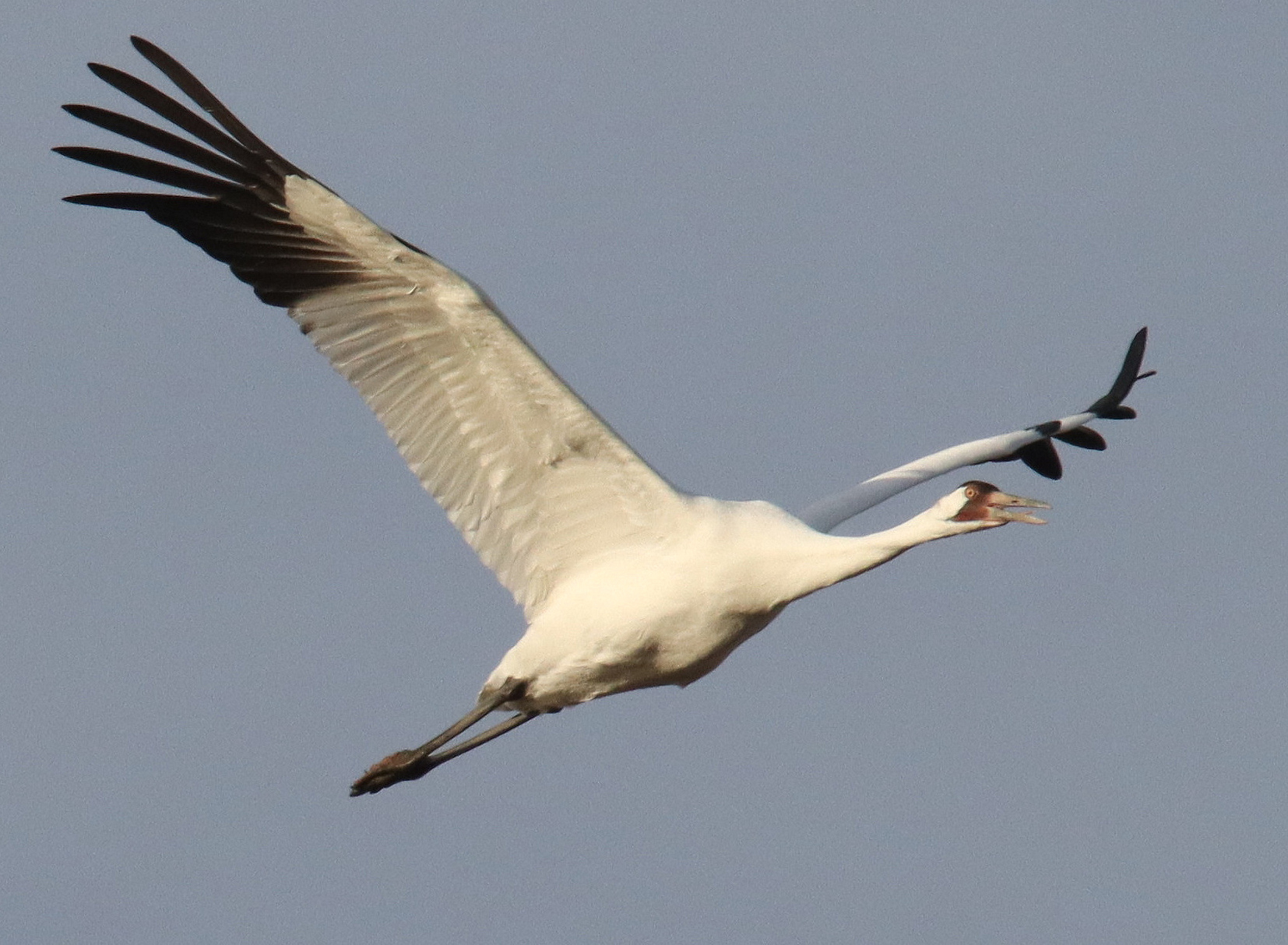
This fall will always be remembered for the manyu Whooping Cranes that brought so many thrills and photo opportunities as they added their trumpeting calls to the Missouri River Valley again!
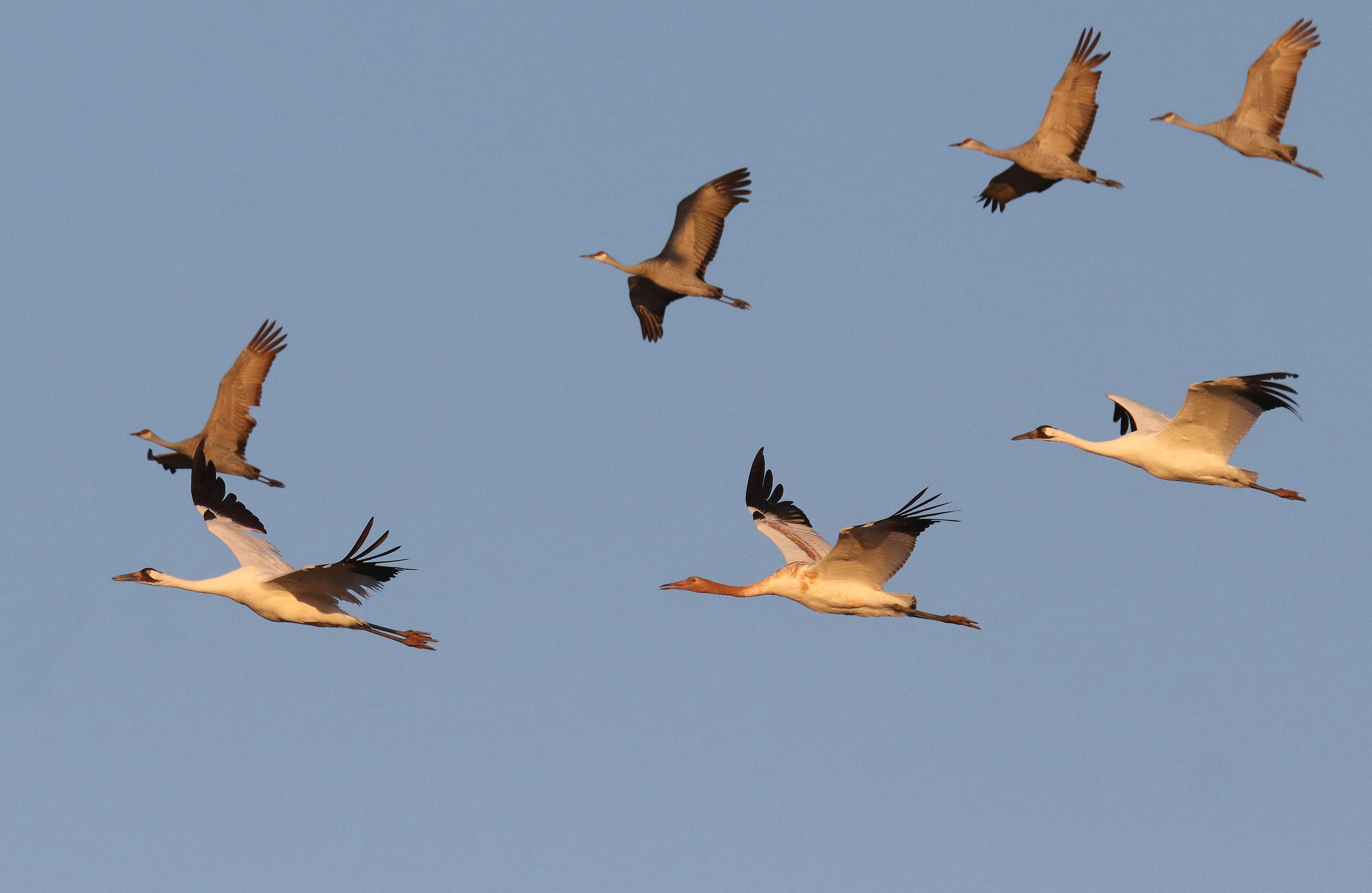
The last family group of Whooping Cranes was photographed as it left the feeding site with about 150 Sandhill Cranes.
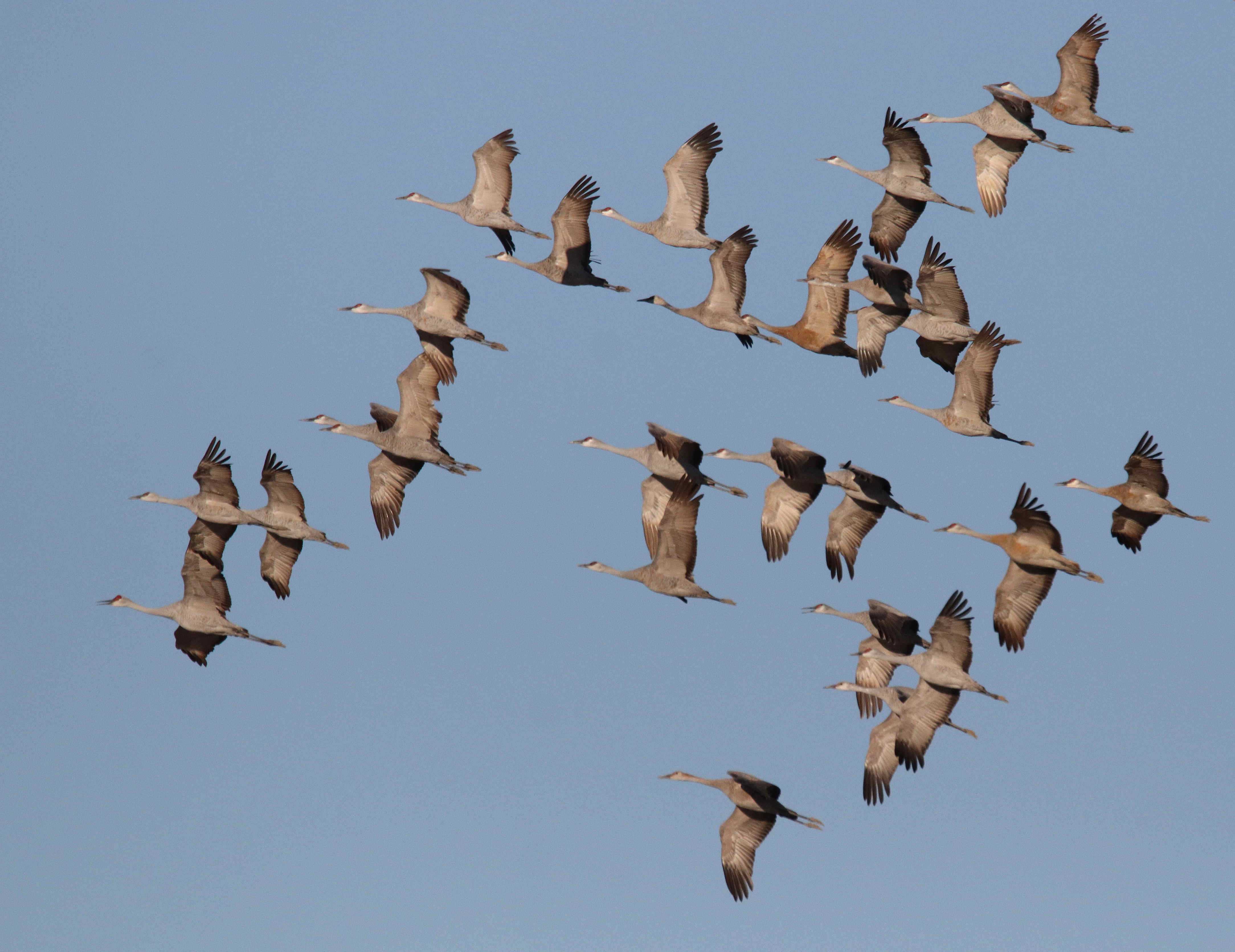
A large flock of late season Sandhill Cranes was made up of the “Lesser” subspecies that nests farthest north in Arctic tundra wetlands.
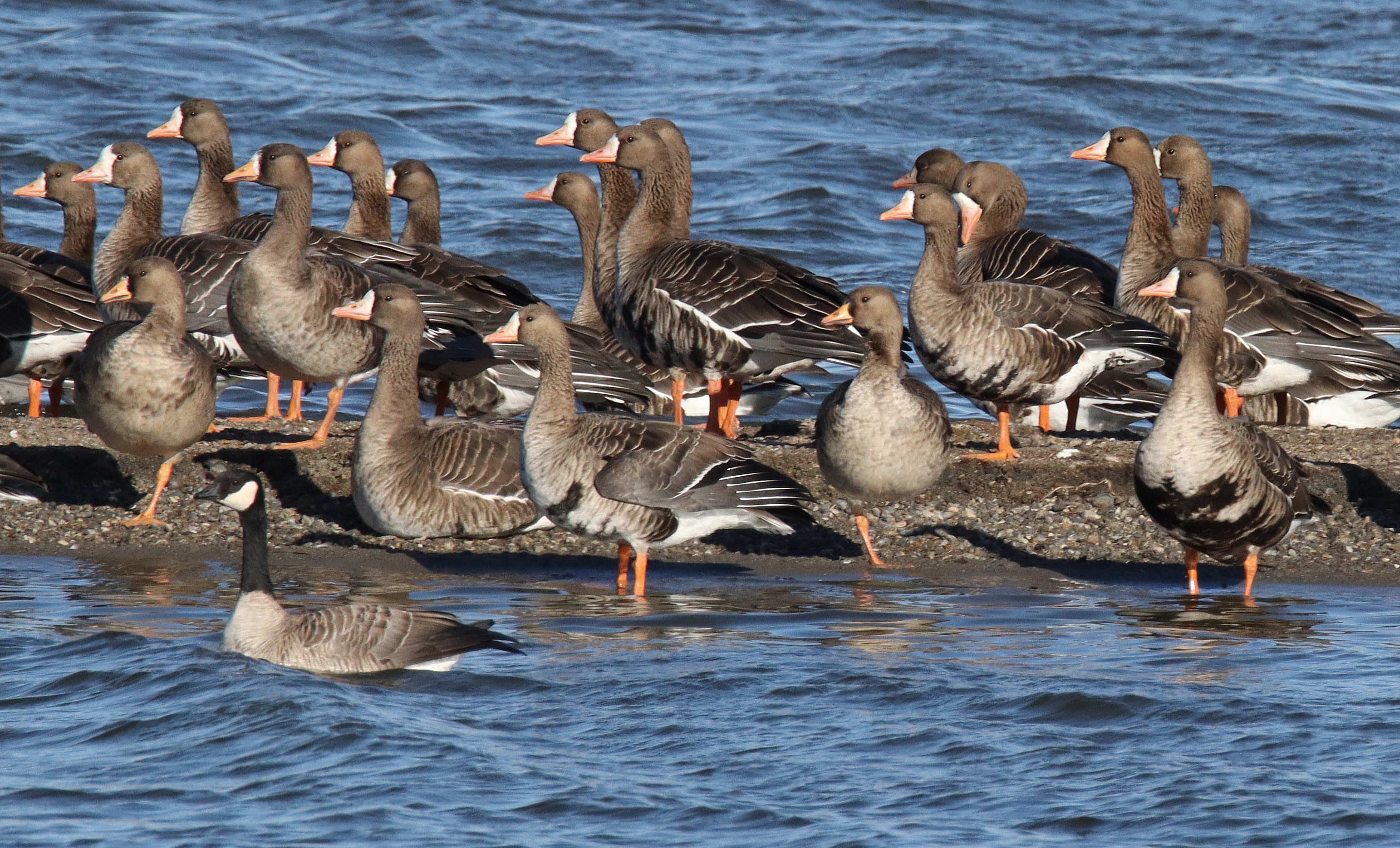
A small portion of a large flock of White-fronted Geese at rest; note the particularly dark-bellied goose to the right, and the smaller Cackling Goose to the left.
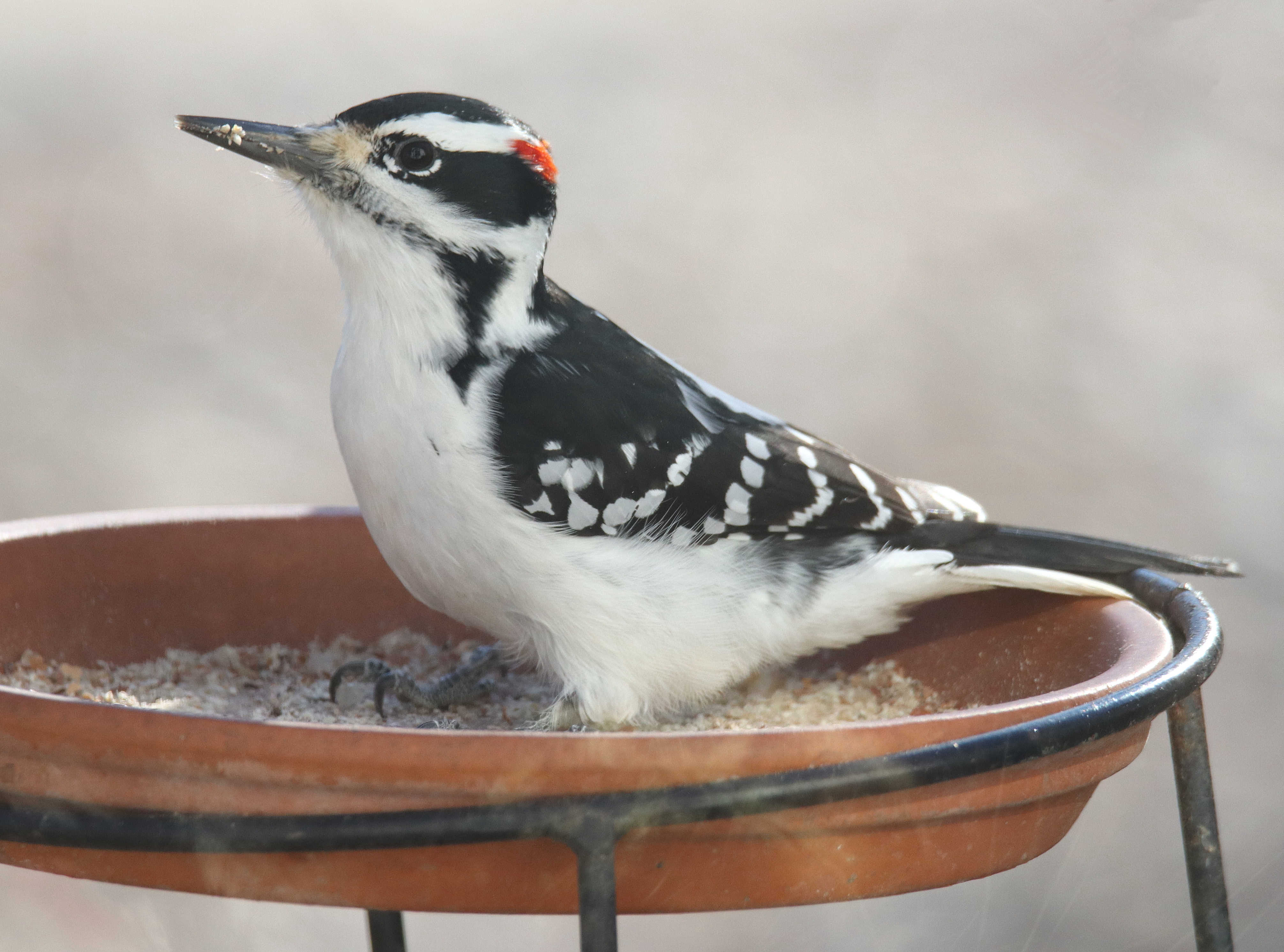
A favorite feeding station visitor has been a male Hairy Woodpecker, although the newest sighting of the season was a Red-breasted Nuthatch that didn’t partake of any feeder fare yet Tuesday afternoon.
|
How do you improve on studying and photographing up to 38 Whooping Cranes during their collective 2 week stopover? Embrace the Arctic nesting birds arriving daily – tens of thousands of geese, mostly Snow, Ross’s, and White-fronted Geese with a few Cackling Geese mixed in; plus Tundra Swans, Rough-legged Hawks, Snow Buntings, Lapland Longspurs, Northern Shrikes, and a mix of northern ducks. But why stop there, embrace the boreal forest birds on hand too: Purple Finches, Pine Siskins, Buffleheads, Merlins, Bald Eagles, and more – it’s an exciting period for birders!
Saturday turned out to be a banner day as long as the sun stayed clear, and an especially enjoyable episode included 2 Rough-legged Hawks as they were hunting along a ridge line, moving to the slope of a high hill, then winging to the next hill crest. It was especially exciting because 1 of the hawks was a dark morph female that provided 2 photo ops, 1 while using the updraft along the ridge to glide and hover, and the other as it glided by me en route to the second hilltop. The way to distinguish a dark morph female from a dark morph male is that dark females are chocolate brown in color, while the males are black. Just before the sun was blotted out of the sky by a thick cloud bank, the chocolate-colored beauty swept ever lower in my direction, then flared to the left, which immersed her in sunlight that provided the best photos of the day – gracias!
A total of 6 Rough-legs were on hand across my route west then north, following the eastern side of the Coteau hills. My main interest was large flocks of geese and swans, and there were many to take in along the way. Three especially large flocks of geese were positioned in an area centered about 35 miles north, but another huge flock was returning to a lake 10 miles north of my office, and there is the ever-growing twin flock just a mile north – twin because the geese utilize 2 lakes about a half-mile apart – Dean’s Lake and an unnamed lake I will hafta name for personal reference – let’s call it Spirit Lake, which measures more than 3 miles long. Tundra Swans appear to be moving a lot day by day among the many lakes I monitor at least weekly, with Cindy’s Lake continuing to hold the most, nearing 100 of the graceful white birds.
Missouri River Valley, Then Home
I did check back on the Whooping Cranes along the Missouri River on my way to Bismarck last Wednesday, but I didn’t find any initially. At sunset a family group of 3 was present in one of the shallow roosting lakes – down 22 from my previous Sunday survey. Between my initial arrival in the area and sunset, it was great fun to have a little spare time to visit my friends Chris and Barb, who I found relaxing on comfy chairs on their property atop a riverside bluff. We sat and talked as flock after flock of Sandhill Cranes flew back to the riverbottom wetlands, and as a few Sharp-tailed Grouse winged by or perched in a nearby tree. What a great opportunity to soak in the sun on a mid-November afternoon with friends and cranes, and Ring-necked Pheasants. Barb and Chris also informed me that the family group of Whooping Cranes was present Friday, and again Sunday.
Earlier, at the location where I observe 3 Golden Eagles the previous Thursday, I found 1 Golden perched just below the crest of a tall butte, probably to stay out of the wind during a rest period or while scanning for potential prey. While Golden Eagles are quite uncommon in the region, that makes 3 Golden Eagle sightings at the buttes during 4 recent drive-bys. Although this Thursday didn’t produce exceptional birding in my local area, aside from the 10,000-plus geese, I did see a representative of a variety of raptor species: A Bald Eagle was circling from side to side above one of the twin flocks of geese, flushing geese a thousand at a time; and that significant observation was followed by sightings of a Merlin, Rough-legged Hawk, Red-tailed Hawk, and Northern Harrier.
With sunshine prompting another afternoon birding drive Sunday, I drove north about 45 miles to Interstate 94 to get a better idea of geese north of my recent meanderings that are usually limited to 15 miles north. I wasn’t surprised by the 2 large flocks primarily made up of many thousands of Snow Geese with Ross’s Geese mixed in. Actually, the biggest concentration could be seen by travelers bisecting North Dakota from the highway near the tiny town of Cleveland, as flock after flock left the big lake to feed in a harvested cornfield just a football field away from the Interstate exit.
With Rough-legged Hawks adding appreciably to Saturday’s outing, these Arctic hawks were my primary focus Sunday, hoping to get more photographs of the widely scattered species. I had good luck, seeing 7 total, all single birds, and 2 provided some quality photo opportunities. Other standout birds included a late Great Blue Heron, 3 flocks of Snow Buntings, 2 flocks of Lapland Longspurs, and a Bald Eagle. There were also a few flocks of Tundra Swans along my drive, all in the usual locations, including 26 at Dean’s Lake, close to home.
As I returned to my office a half-hour before sunset, it was insightful to see 7 large clouds of geese on their way to feeding fields between my friend Dave’s farmstead and my abode – along a route of about 10 miles distance from north to south. The biggest concentration of thousands of Snow and Ross’s Geese was nearest Dave’s place, and a slightly smaller cloud of geese was feeding just a half-mile west of my home. In addition, a much smaller flock of about 150 White-fronted Geese was feeding just a quarter-mile south of my house, with those birds eventually overnighting at Melody’s Marsh with a flock of Canada Geese and a couple Cackling Geese.
Monday, Monday
As pink hues were fading in some high clouds before sunrise Monday morning, the geese began returning to their select harvested cornfields, adding the first avian action to the day and the first sounds of nature to the crisp air. Ah, goose stopover time; what an exciting time of late fall. The next sound were the distant calls of Blue Jays that became louder until they emanated from my feeding station. That’s when a Dark-eyed Junco appeared, a species I haven’t seen in the area for a couple weeks, and it was followed by an especially colorful “Oregon” junco – and so the day began.
Some days American Goldfinches and Pine Siskins filter in to my feeding station, and a single Purple Finch seems to stop in day by day, a male Thursday, a female Friday, and a very colorful male Saturday. A male Hairy Woodpecker continues to be a favorite daily regular, White-breasted Nuthatches are a staple, as are House Finches, and at least 4 Blue Jays add color, voice, and character to the feeding station.
Just before 4pm the geese were announcing their flights to their afternoon feeding session, calling en masse above my office, trying to lure me outside no doubt. They had pretty good success, although I didn’t venture far – just to check on the goose action within 2 miles, which was substantial. That night there was a change in the weather – rain – which would lead to a dramatic change in the form of high winds and snow Tuesday, with even more snow Tuesday night and Wednesday. Hopefully the afternoon appearance of the first Red-breasted Nuthatch of the season was a harbinger of good things to come as the high temperatures for the rest of the month will be below freezing.
That can be good, but it signals the end is coming. But first, the big concentrations of geese will come, with more Bald Eagles, and it will be fun to see how things change around here by Thursday – I’ll keep you posted. In the meantime, try to plan some quality birding time into your Thanksgiving holiday break; and don’t hesitate to invite family members or friends along for the experience. Share your optics, and enjoy sharing insights to the birds you find. Enjoy birding anywhere, any day!
Article and Photos by Paul Konrad
Share your bird sightings and photographs at editorstbw2@gmail.com